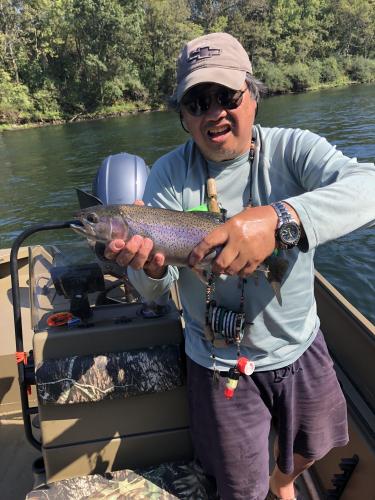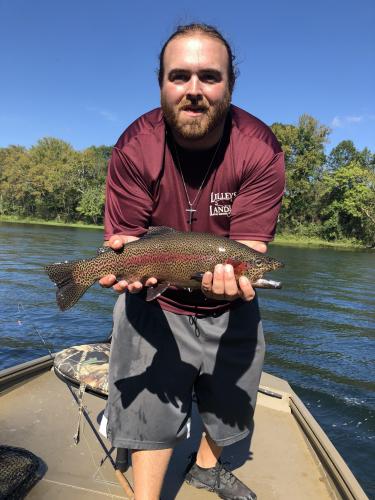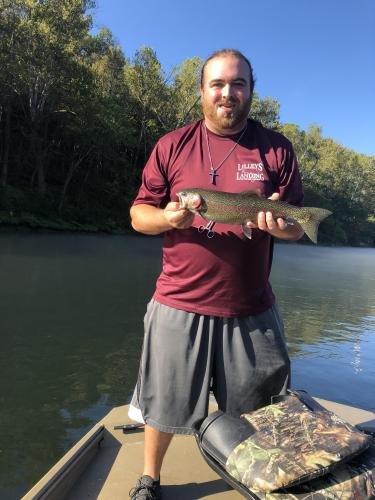Summer has stuck around late this fall (yes it has officially been autumn for a week now despite the 90-plus degree weather.) But we know the splendor of fall colors is just weeks away! It looks like we're in for a cool change this week.
We've received a little heavy generation already this week, I assume because of the hot weather. It sure was nice, though, moving a lot of loose pond weed and other floating scum out of our area of the lake. That's one nice thing about being on a tail water -- we get new water every time operators run water at the dam.
They're still running that minimum flow 24/7 as they have been since September 1st. No word of any changes on the horizon. Dissolved oxygen levels have been holding up pretty well, and water temperatures are about 57 degrees. When they do switch modes and start leaving the water off, I think we'll see no generation for most of the time and little generation until cold weather dominates our days and nights.
The San Juan worm continues to be the hot item this week, mentioned on social media many times as the go-to fly. The best colors are pink and red in the micro version, which is basically a small diameter chenille tied on a #14 or #16 hook. The material is called micro chenille . . . go figure.
Most fly fishers are using the micro San Juan in a double fly rig under an indicator. They're using a heavier fly up from the San Juan about 18- to 24-inches from, say, a weighted scud or a beaded midge. But you could use a beaded version of a San Juan by itself since the bead would take the fly down where it needs to be.
You want to fish the worm, and scuds for that matter, on the bottom when drifting along in the current, so set the indicator at a depth where the flies rake across the bottom. If your flies are coming back with Taneycomo slime, move the indicator so that you're not fishing as deep. But you'll drift across shallow and deep areas, holes and flats, and will need to pick a good average depth to cover as much water as possible.
Our dockhand Blake Wilson has been fly fishing quite a bit, scoring really well using a double scud rig. He's fishing a peppy scud (medium gray), two sizes under a float and drifting from the cable below the dam down to Trophy Run. He ties the smaller scud, usually a #16 or #18, as the bottom fly and a larger #14 on top, separating them by about 18 inches. He's using 6x fluorocarbon tippet.
As far as where to fish either of these rigs, any fairly shallow gravel flats are best, and you'll find those areas from the dam down to Trout Hollow Resort. From Fall Creek to Trout Hollow, stay towards the inside of the bend.
Drifting real worms is still the best way to catch trout below the trophy area. These two things will help you catch more fish.
First, your weight. Your weight needs to match the flow of generation. When you throw the rig out, how long does it take to hit the bottom? If it goes right to the bottom, and you feel it catch and pull, you're using too much weight. Depending on the depth of water, of course, it should take a few seconds to reach the bottom, and you should feel a slight touch every once in a while. When this happens, you know your bait is skimming across the bottom like a natural worm would. Plus when a fish picks it up, you'll feel it immediately.
With the present generation, all you really need is a small split shot to get your bait to the bottom. And less is better. Even if your bait isn't on the bottom all the time, it will get eaten. With too much weight you will only catch, snag and grow frustrated.
The second thing is how you present your worm. Don't use the whole worm. No need to thread it, although that’s not a bad option -- it just takes too much time and is unnecessary. Pinch the worm in two. Take the piece and run your hook through the middle, letting it hang off each side. No need to hide the hook. I use a #8 short shank bronze hook by the way. And four-pound line is fine when drifting.






Recommended Comments
Create an account or sign in to comment
You need to be a member in order to leave a comment
Create an account
Sign up for a new account in our community. It's easy!
Register a new accountSign in
Already have an account? Sign in here.
Sign In Now